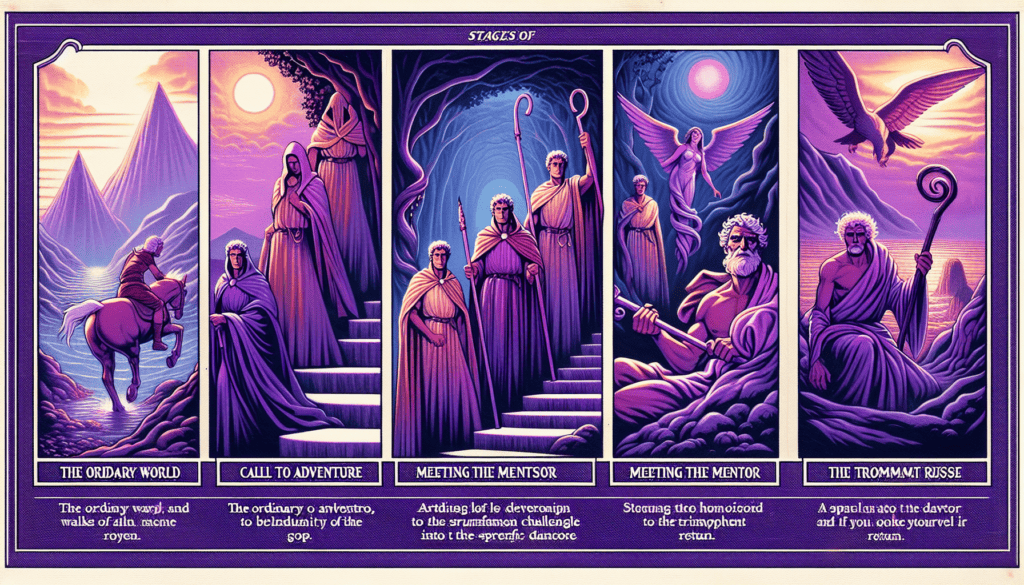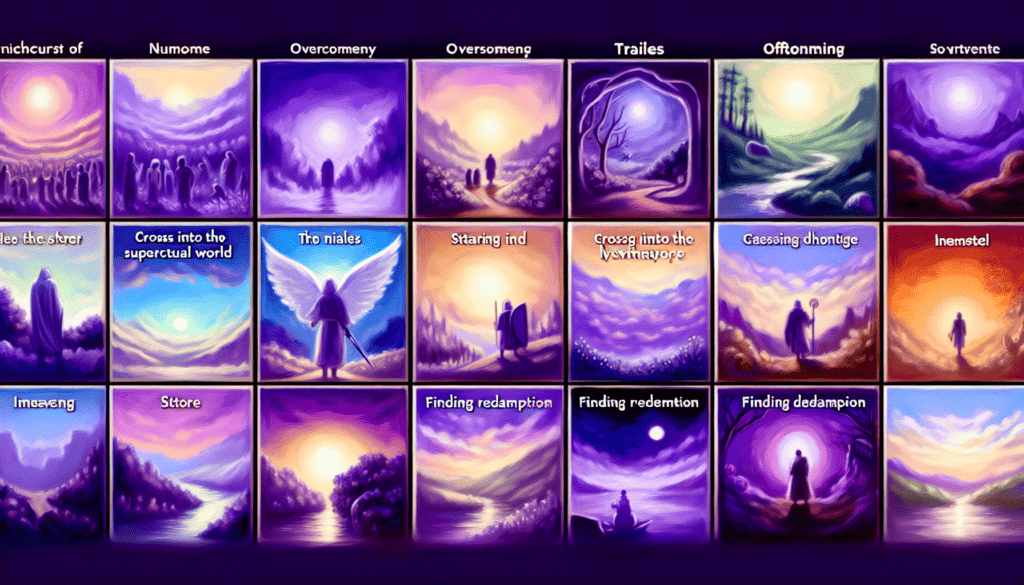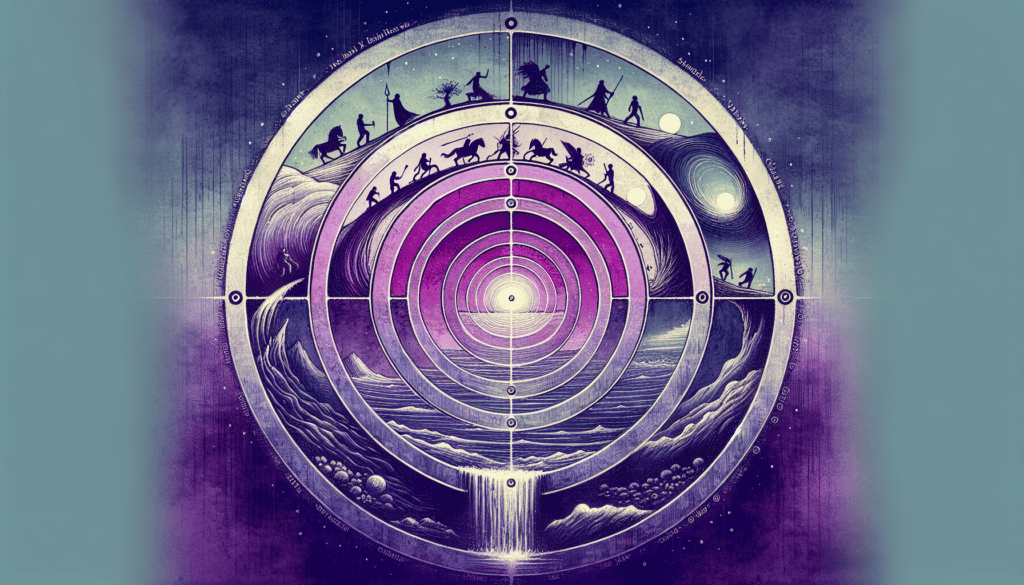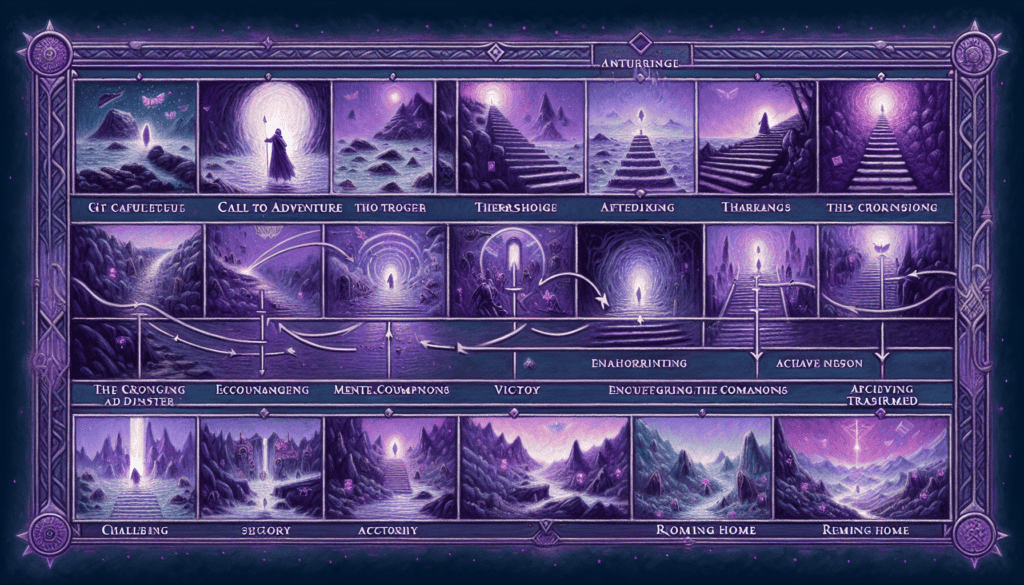The Journey Begins
In every tale of personal transformation, there are key moments that signify the start of an epic journey. These initial stages of the Hero’s Journey set the stage for growth and discovery.

Call to Adventure
The Call to Adventure is the moment that propels me from my familiar world into the unknown. This stage can take many forms and might come about through a sudden realization, an unexpected event, or a conscious decision to seek change. It’s the spark that ignites my journey towards personal growth and self-discovery.
For example, in literature and movies, this stage is often depicted as a clear invitation or a dramatic event. Frodo receiving the One Ring in “The Lord of the Rings” and Harry Potter learning about his wizard heritage are classic examples of the Call to Adventure. In my own life, it might be the decision to pursue a new career, move to a different city, or take on a significant challenge.
| Example Hero | Call to Adventure |
|---|---|
| Frodo Baggins | Receives the One Ring |
| Harry Potter | Learns he is a wizard |
| Katniss Everdeen | Volunteers as tribute |
Refusal of the Call
After the Call to Adventure, it’s common to experience resistance, known as the Refusal of the Call. This stage represents the internal conflict that arises when faced with the unknown. I might feel fear, doubt, or reluctance to leave the safety of my familiar environment.
The Refusal of the Call reminds me that stepping into the unknown is not easy. It highlights my vulnerabilities and fears, making it a crucial part of the journey. For example, in “The Matrix,” Neo initially hesitates to take the red pill, representing his reluctance to embrace the truth.
While the Refusal of the Call might seem counterproductive, it’s an important step that allows me to acknowledge my fears and prepare mentally for what lies ahead. Overcoming this initial resistance sets the foundation for true personal growth and resilience.
Explore more on the hero’s journey steps to understand how each phase contributes to the narrative structure.
By understanding these early stages of the hero’s journey archetype, I can better appreciate the transformative potential that lies in embracing life’s challenges. These moments mark the beginning of a path towards self-improvement and personal development, where every step forward brings new insights and growth opportunities.

Seeking Guidance
In everyone’s journey, guidance is a pivotal part that shapes the path ahead. Let’s dive into the hero’s journey examples to understand how meeting a mentor and crossing the threshold play crucial roles.
Meeting the Mentor
I remember the first time I encountered a mentor. This figure is essential in the hero’s journey steps, offering wisdom, confidence, and practical skills. It’s like when Barbie met Gloria in Greta Gerwig’s “Barbie.” Gloria provides Barbie with insights into the human world, helping her transition from a perfect doll to a real person (bybrittonperelman.com).
Mentors can take many forms – a wise elder, a caring teacher, or even a friend. Their primary role is to prepare the hero for the trials that lie ahead. They can offer lessons or give magical gifts like Gandalf in “The Lord of the Rings,” guiding and supporting at every crucial step.
Crossing the Threshold
Crossing the threshold represents a point of no return in the hero’s journey archetype. It’s that moment when I truly step out of my comfort zone, beginning a series of trials and adventures. In storytelling, this is where the hero leaves the ordinary world and enters a new, unknown realm.
Take the example from “Barbie” again. Barbie and Ken physically leave Barbie Land, crossing various places until they land in the real world (bybrittonperelman.com). This step marks the end of Act One in the hero’s journey, leading straight into new experiences and challenges.
Understanding these stages, like meeting the mentor and crossing the threshold, helps me see my own journey differently. These elements contribute significantly to personal growth and transformation. For more detailed examples and steps, check out our guide on the hero’s journey diagram.

Challenges and Allies
In the hero’s journey, challenges and allies play crucial roles in shaping the protagonist’s path and personal growth. This section explores the tests and trials faced, as well as the allies and enemies encountered along the way.
Tests and Trials
The tests and trials are pivotal moments in the hero’s journey where the protagonist is pushed to their limits. These challenges are designed to test their resolve, skills, and character. Facing trials not only helps the hero grow but also prepares them for greater ordeals ahead.
For instance, in the film “Rocky,” Rocky Balboa trains intensively, facing physical and mental challenges to prepare for his big fight. Similarly, in “The Martian” by Andy Weir, Mark Watney encounters a series of life-threatening situations on Mars, testing his ingenuity and determination.
Here are some common types of tests and trials heroes might face:
- Physical Challenges: Endurance tests, battles, survival scenarios.
- Mental Challenges: Puzzles, strategic decisions, overcoming fear.
- Emotional Challenges: Dealing with loss, betrayal, self-doubt.
For more on the steps involved, visit our hero’s journey steps article.

Allies and Enemies
Throughout the journey, heroes are rarely alone. They encounter a mix of allies and enemies who significantly impact their progress.
Allies
Allies provide support, guidance, and companionship. They help the protagonist make crucial decisions, offer their skills, and sometimes save the hero from dire situations. In “The Fellowship of the Ring,” for example, Frodo has Samwise, Gandalf, Aragorn, and the rest of the fellowship to assist him on his quest. These allies bolster the hero’s strength and often share the burden of the trials.
Enemies
Enemies, on the other hand, are antagonists that hinder the hero’s progress. They can be rival characters, internal fears, or systemic obstacles. These enemies challenge the hero, forcing them to dig deep and find new strategies for overcoming adversities. In “The Martian,” Mark Watney’s enemy is the unforgiving Martian environment itself, which constantly threatens his survival.
| Examples | Allies | Enemies |
|---|---|---|
| “Rocky” | Mickey (trainer), Adrian (supportive partner) | Apollo Creed, Self-doubt |
| “The Martian” | NASA Team, Astronaut Crew | Mars Environment, Isolation |
| “The Fellowship of the Ring” | Sam, Gandalf, Fellowship Members | Sauron, Uruk-hai, Ring’s Corruption |
Understanding the dynamics of tests, allies, and enemies enriches the narrative structure of the hero’s journey. The hero’s interactions with these elements lead to profound personal growth and transformation. For a detailed breakdown of this storytelling pattern, view our hero’s journey diagram.
Discover more about how heroes face these challenges and the archetypes involved at our hero’s journey archetype page.
Innermost Discoveries
Approach to the Cave
In the hero’s journey, the “Approach to the Cave” marks a critical moment. It’s a stage where I, the protagonist, must prepare for a significant challenge. This isn’t just a physical cave but a metaphorical space filled with my deepest fears and uncertainties.
When I reach this stage, I often find myself facing internal struggles and doubts. It is where I gather my resources, reassess my goals, and prepare for the upcoming ordeal. Some hero’s journey examples highlight this phase beautifully:
| Hero | Journey to the Cave |
|---|---|
| Frodo Baggins | Approaches Mount Doom |
| Harry Potter | Confronts Voldemort in the Chamber of Secrets |
| Katniss Everdeen | Enters the Capitol’s dangerous territories |
This stage resonates deeply with me as it’s a turning point. I realize that the next step will define my journey, testing my resolve and commitment.
Facing the Ordeal
The “Facing the Ordeal” step is where I encounter the greatest challenge in my journey. It’s a pivotal point where everything hangs on a thread. The ordeal can be a life-or-death crisis or an intense battle, pushing me to my limits.
In many hero’s journey examples, this stage represents a moment of intense fear and difficulty. For me, it’s a test of my newfound skills and strength. This stage often brings out the best and worst in me, revealing aspects of my character I wasn’t aware of.
To illustrate this with a well-known example:
| Hero | Ordeal Faced |
|---|---|
| Luke Skywalker | Battles Darth Vader |
| Simba | Faces Scar in the Lion King |
| Neo | Confronts Agent Smith in the Matrix |
Understanding this stage helps me see that the ordeal is not just a physical challenge, but an emotional and intellectual one as well. It’s a moment of catharsis, where I break free from my fears and emerge stronger.
For those on their own hero’s journey, remembering these stages can provide valuable insight. Preparing for the cave and facing the ordeal are crucial steps in achieving personal growth. To explore more about the stages of the hero’s journey or dive deeper into the hero’s journey archetype, check out our detailed guides.
Transformation and Rewards
In the transformative phase of my hero’s journey, I encounter profound growth and the ultimate reward for my endeavors. This pivotal stage is marked by the claiming of the reward and the road back home.
Claiming the Reward
Having faced numerous trials and tribulations, I finally reach the moment of triumph where I claim the reward. This reward can be tangible or symbolic, representing the culmination of my efforts and the knowledge gained along the way. The reward signifies the newfound wisdom, skill, or treasure that I have acquired.
In my journey, the reward resonates deeply with the universal themes of self-discovery and transformation. As I grasp the reward, I realize that it is not merely an external prize but also an internal growth. This duality of the reward embodies both physical and emotional enrichment, fulfilling the hero’s journey archetype. For more on this, explore the hero’s journey archetype.
| Hero’s Journey Phase | Description |
|---|---|
| Call to Adventure | The hero is called to leave their ordinary world. |
| Refusal of the Call | Initially hesitant, the hero declines the adventure. |
| Meeting the Mentor | A guide appears to provide wisdom and support. |
| Crossing the Threshold | The hero enters the unknown realm, beginning the journey. |
| Claiming the Reward | The climax where the hero gains what they sought. |
The Road Back Home
After claiming the reward, my journey does not end there. The road back home presents its own set of challenges and realizations. This part of the hero’s journey is critical, as it involves returning to the familiar world, now changed by the experiences and knowledge gained.
In my return, I carry the essence of the journey with me, integrating the lessons learned into my everyday life. The road back often signifies a period of reflection and adaptation, where I must reconcile my new insights with the world I once knew. This stage is crucial for solidifying the transformation and ensuring that the journey has a lasting impact on my personal development.
For a comprehensive understanding of the steps involved in the hero’s journey, visit our guide on hero’s journey steps.
The return journey can sometimes be fraught with further tests, but ultimately, it reinforces the hero’s newfound strength and resilience. By embracing the hero’s journey framework, I gain a clearer perspective on my life’s narrative, allowing for continuous growth and self-improvement. For visual learners, our hero’s journey diagram provides a helpful representation of these stages.
Through the claiming of the reward and the road back home, I transform into a wiser and more enlightened individual, ready to apply the lessons of my journey to future adventures.
Embracing Change
Resurrection
In the Hero’s Journey, the Resurrection stage represents an intense moment of transformation. It’s the ultimate test where I confront my deepest fears or face a perilous battle. This stage symbolizes a form of rebirth, where I emerge stronger and more enlightened.
For instance, in the movie “Barbie,” the Resurrection involves an epic musical number where the Barbies ingeniously turn the Kens against each other, seizing control and ensuring their own emancipation (bybrittonperelman.com). This moment is a crucial turning point where Barbie truly transforms, preparing her for the final stage of her journey.
Return with Wisdom
The final stage of the Hero’s Journey is the Return with Wisdom. After surviving the Resurrection, I bring back valuable knowledge or a “boon” that can benefit my community or myself. This is more than the physical return—it’s about integrating experiences and newfound insights into everyday life.
In “Barbie,” the Return signifies Barbie choosing to become human and live in the Real World, embracing the complexities of womanhood and humanity (bybrittonperelman.com). This decision showcases her completion of a full-circle story, symbolizing personal growth and a deeper understanding of her place in the world.
To see how these stages fit within the overall journey, you can refer to our hero’s journey diagram and explore the stages of the hero’s journey. These tools help in visualizing and understanding the path each hero takes, making it easier to relate these examples to real-life adventures and personal growth.




